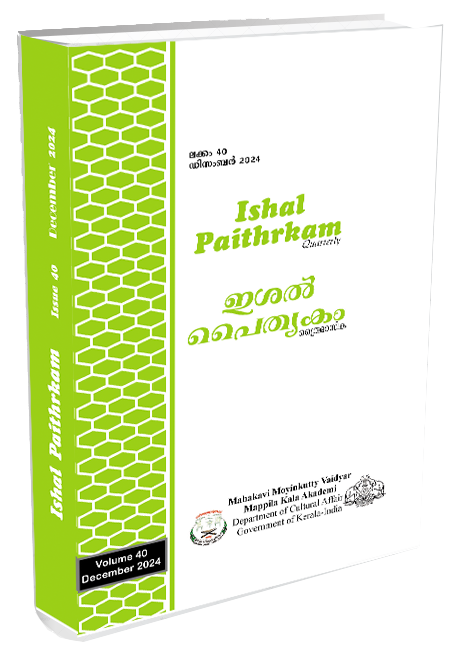Theatre and Spectator:Revisiting Shankara Pillai's Avatharanam Brandhalayam
Keywords:
Realism, Absurd Philosophy, Alienation effect, Fourth wall, meta theatreAbstract
An in depth probing into the history and evolution of Malayalam drama will reveal that it has originated and flourished
deriving sustenance from translations of Sanskrit and European plays. Writers like C V Raman Pillai who had
written very serious history plays took to writing farces in order to vehemently criticize the voguish, pretentious hypocrisies
of his own natives of Thiruvananthapuram and thus entered the domain of drama."Farces designed in accordance with
Western imagination, elicited humour from the despicable, strange and ridiculous facets of the social life of the public"
(Shankarapillai,1987: 45). Farces and balets that emerged initially also testify the mimetic nature that Malayalam drama
posessed initially. Following the dictates of prevalent dramaturgy, Munshi Ramakurup wrote Chakkichankaram. This play
pungently criticised and assaulted the profusion of plays which claimed to be indigenous, but were totally meaningless and
pointless. The operas which came into being during this time reveal tremendous influence of Tamil. "Although there was a
proliferation of operas written in Malayalam inspired by the Tamil balets and operas which was being very popular on the
stage, only Sadarama was rich in its literary value and musical content and achieved success" (N Krishna Pillai, 2018:
262).This play written by K C Kesava Pillai was the only play that conqered the hearts of the spectators with it's dramatic
element and beauty.
Despite having a history of around 142 years, one of the defects of this visual art form with regard to Malayalam is
that for a long time the dramatic genre was regarded as a part of literature, but theatre wasn't. As T M Abraham observes,
"we were unaware of the fact that playwrights, theatre and spectator should compliment each other and that this visual art
form arises as a result of the confluence of all the three" ( Abraham, 2007: 22). Akin to the prevalent notion that any one
could write a play, Munshi Ramakurup came out with his pungently critical play Chakkichankaram. Subsequently many
political plays emerged following Aristotle's theory of mimesis. Likewise problem plays and plays focussing on social
themes were produced. Playwrights like CJ Thomas and Pulimana Parameswaran Pillai ushered in innovative strategies in
Malayalam drama. Plays that directors feared to stage were composed and directed by revolutionary playwrights like G
Sankara Pillai. Sankara Pillai dismantled conventional Malayalam dramaturgy and brought forth highly experimental plays.
Through his plays the Malayali spectator got acquainted with European trends in playwrighting. Sankara Pillai wrote
realistic plays, one act plays, absurd plays and indigenous plays and directed them on stage and even provided training for
such plays. The influence of Bertolt Brecht and Samuel Beckett is evident in Sankara Pillai's plays. His play "Avatharanam
Brandhalayam", written in 1980, is an experimental play which adopts many unique, novel techniques employed by European
playwrights. This article proposes to explore and assess theoretically the play "Avatharanam Brandhalayam".
Downloads
References
Sankarapillai, G. (1987). Malayala Nataka Sahithya charithram. Thrissur: Kerala Sahithya Academy.
Krishna pillai, N. (2018). Kairaliyude Katha. Kottayam: DC books.
Abrham, T. M. (2007). Nataka Padanangal. Prof.Panmana Ramachandran Nair (edi.). Pashchathya Nataka Swadheenatha. Kottayam:Current books.
Pillai, N.N. (2012). Nataka darpanam. Kottayam: Current books.
Thomaskutty, L. (2015). Malayala Sahithyam-3. Malayala Nataka Charithrathinoramukham. Calicut University Press.
Ayyappapanicker. (1990). Nataka darsanam(amukham). G.sankara pillai. Kottayam: Current books.
Thomas, C.J. (2014). 1128 Crime 27. Kottayam: DC books.
Gramaprakash, N. R. (Dr.).(2013). Prathyayasasthravum natakavum. Arangilevargasamaram. Thiruvananthapuram: Chintha Publishers.
Sankarapillai, G. (1985). Sankarapillayude randu Natakangal. Kozhikode: Mathrubhumi books.
Sankarapillai,G. (2023). Malayala sahithyam 3. Bharathavakyam. Kottayam: DC books.
Delores Ringer (1995) Re-Visioning scenography- Theatre and feminist aesthetics Editors Karen, Laughlin and Catherine Schuler
published London press associated University presses 1995 page 302: Print
Bertolt Brecht (1964)-Brecht on Theatre edited and translated John willett NewYork Publisher Hill and Wang page 201: PrintShow quoted text
Downloads
Published
Issue
Section
License
Copyright (c) 2025 ISHAL PAITHRKAM

This work is licensed under a Creative Commons Attribution-NoDerivatives 4.0 International License.

